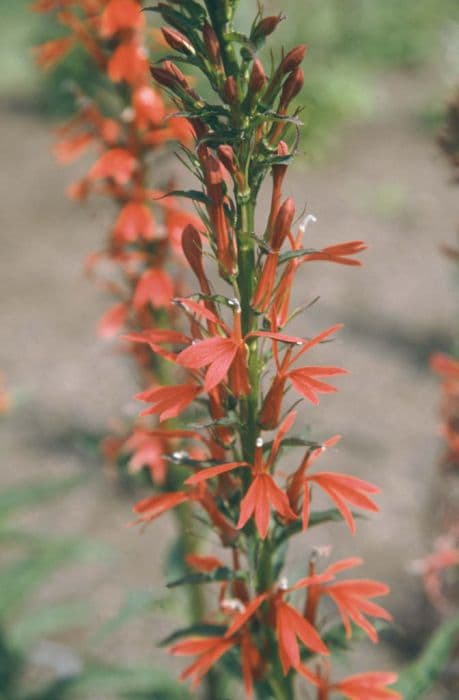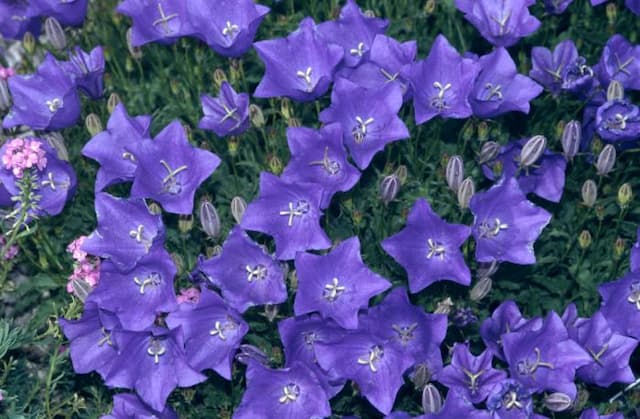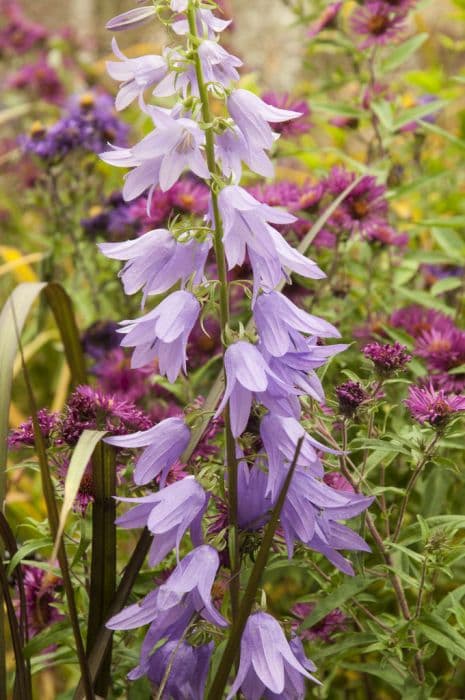Cardinal flower Lobelia cardinalis

ABOUT
L. cardinalis is an erect, clump-forming herbaceous perennial to 90cm in height, with rather glossy bright green oblong leaves and brilliant scarlet, two-lipped flowers 5cm in length in terminal spikes
About this plant
 Names
NamesFamily
Campanulaceae.
Synonyms
Cardinal Flower, Cardinal Plant, Scarlet Lobelia.
Common names
Lobelia fulgens, Rapuntium cardinale, Dortmanna fulgens.
 Characteristics
CharacteristicsLife cycle
Perennials
Foliage type
Deciduous
Color of leaves
Green
Flower color
Red
Height
2-4 feet (60-120 cm)
Spread
1-2 feet (30-60 cm)
Plant type
Herb
Hardiness zones
3-9
Native area
North America
Benefits
 General Benefits
General Benefits- Attracts wildlife: Lobelia cardinalis, also known as cardinal flower, is known for attracting hummingbirds, butterflies, and other pollinators to the garden.
- Ornamental value: With its vibrant red flowers, the cardinal flower adds aesthetic appeal and a splash of color to gardens and landscapes.
- Native plant gardening: As a native North American species, the cardinal flower is well-suited for native plant gardens, supporting local ecosystems and biodiversity.
- Erosion control: Its root system can help stabilize soil and prevent erosion in moist or riparian areas.
- Adaptability: Cardinal flower can thrive in a variety of wet environments, including stream banks, pond edges, and damp garden beds.
- Low maintenance: Once established in appropriate conditions, Lobelia cardinalis requires minimal care, making it a convenient choice for gardeners.
 Medical Properties
Medical Properties- Expectorant: Lobelia cardinalis has been traditionally used to help remove mucus from the respiratory tract.
- Diaphoretic: The plant may induce sweating which was thought to help in fever management.
- Anti-spasmodic: Used traditionally to alleviate muscle spasms and cramping.
- Calming effects: Consumed in small doses, it has been said to have a calming effect on the nervous system.
 Air-purifying Qualities
Air-purifying QualitiesThis plant is not specifically known for air purifying qualities.
 Other Uses
Other Uses- Lobelia cardinalis, also known as Cardinal Flower, is often used as a striking focal point in water gardens or along ponds and streams due to its vibrant color and affinity for moist soil.
- Butterfly and hummingbird attractant – The Cardinal Flower's bright red flowers are a magnet for butterflies and hummingbirds, making it a popular choice for wildlife gardens and naturalistic landscapes.
- The plant can be used in dye production, where its flowers can provide a source of red pigment for natural dyeing processes.
- As an educational tool, the Cardinal Flower is used to teach about plant-pollinator relationships, specifically the specialization of long-tubed flowers for hummingbird pollination.
- The plant can function as a natural erosion control mechanism on riverbanks or slopes due to its dense root system.
- In ornamental crafts, the dried stalks and seed pods of Cardinal Flower can be used in floral arrangements and nature-inspired art.
- It serves as a model organism in botanical studies due to its easily observable floral morphology and pollination strategies.
- Garden aesthetics – Incorporated into moon gardens where its bright blossoms stand out during twilight, providing a unique visual appeal.
- Native plant education – Cardinal Flower is used in educational programs to promote the use of native plants in landscaping to support biodiversity.
- Photography subject – Its striking appearance and vibrant red flowers make it a favorite subject for photographers specializing in plant and nature photography.
Interesting Facts
 Feng Shui
Feng ShuiThe Cardinal Flower is not used in Feng Shui practice.
 Zodiac Sign Compitability
Zodiac Sign CompitabilityThe Cardinal Flower is not used in astrology practice.
 Plant Symbolism
Plant Symbolism- Distinctiveness: The bright red flowers of the Cardinal Flower (Lobelia cardinalis) stand out in nature, symbolizing uniqueness and individuality.
- Attraction: Cardinal Flower is known to attract hummingbirds, symbolizing allure and magnetism.
- Vitality: The vibrancy of its red petals represents life force and energy.
- Spiritual Enlightenment: Due to its intense color and upward growth, it can symbolize spiritual or religious fervor.
- Love: Red being a traditional color for passion and love, the Cardinal Flower is sometimes used to represent deep emotions and desire.
 Water
WaterCardinal flower should be watered deeply to ensure the soil is moist but not waterlogged. During the growing season, check the soil moisture regularly; if the top inch feels dry, it's time to water. Generally, this amounts to around 1 inch of water per week, but may vary based on climate conditions. During hot, dry periods, watering frequency should be increased to prevent the soil from drying out, potentially every 2-3 days. Be careful not to overwater, as standing water can lead to root rot. It's best to water early in the morning or late in the afternoon to reduce evaporation.
 Light
LightCardinal flower thrives in partial shade to full sun. The ideal location provides morning sunlight and afternoon shade, especially in areas with hot summers. They can also grow well in dappled sunlight under open trees. Avoid places with intense, direct afternoon sun, which can scorch the leaves and stress the plant.
 Temperature
TemperatureCardinal flower performs best in temperatures ranging from 60 to 70 degrees Fahrenheit but can tolerate a broader range, from 50 to 85 degrees Fahrenheit. It's hardy and can survive winter temperatures down to 20 degrees Fahrenheit, but ensure that the root zone is well-mulched for protection. Avoid locations where temperatures frequently exceed 90 degrees Fahrenheit, as this can impair the plant's health and flowering.
 Pruning
PruningPrune the cardinal flower to remove spent flowers and encourage a second bloom. Deadheading, or cutting off the faded flower spikes, can prolong the blooming period. After the first killing frost, cut the plant back to ground level. Throughout the growing season, remove any yellowing or damaged leaves to maintain the plant's appearance and health. Pruning is typically done in late fall or early spring.
 Cleaning
CleaningAs needed
 Soil
SoilThe best soil mix for Cardinal Flower (Lobelia cardinalis) is rich, moist, and well-draining with a pH of 6.0 to 7.0.
 Repotting
RepottingCardinal Flower should be repotted every 1-2 years, preferably in the spring before new growth begins.
 Humidity & Misting
Humidity & MistingCardinal Flower thrives in average to high humidity levels.
 Suitable locations
Suitable locationsIndoor
Keep Cardinal Flower in bright, indirect light indoors.
Outdoor
Plant Cardinal Flower in partial shade, keep soil moist.
Hardiness zone
3-9 USDA.
 Life cycle
Life cycleCardinal flower (Lobelia cardinalis) starts its life as a seed, often requiring stratification or a period of cold to break dormancy before germination can occur in moist soil conditions. After germination, the seedling emerges and develops into a rosette of basal leaves during its first year, focusing on root and foliage growth. In the second year, the cardinal flower sends up a flowering stalk that can reach up to 4 feet tall, with the plant blooming in late summer to early fall, revealing vibrant red flowers that are highly attractive to hummingbirds and other pollinators. After pollination, the plant produces fruit in the form of small capsules containing numerous tiny seeds that are dispersed by wind and water. In favorable conditions, these seeds will propagate new plants, continuing the lifecycle. Cardinal flowers are perennial, and while individual plants may live and bloom for several years, they often propagate through self-seeding and can also spread vegetatively through clonal growth from rhizomes.
 Propogation
PropogationPropogation time
Spring to Summer
The most popular method of propagation for the Cardinal Flower, or Lobelia cardinalis, is by seed. Ideally, the seeds should be sown in late winter or early spring. The tiny seeds can be scattered on the surface of a moist seed-starting mix and gently pressed into the medium, as they require light for germination. They are best germinated at a temperature of around 70°F (21°C), and germination typically takes 2-3 weeks. Seedlings can be transplanted into individual pots once they have a couple of true leaves and can be moved outdoors after the risk of frost has passed.









